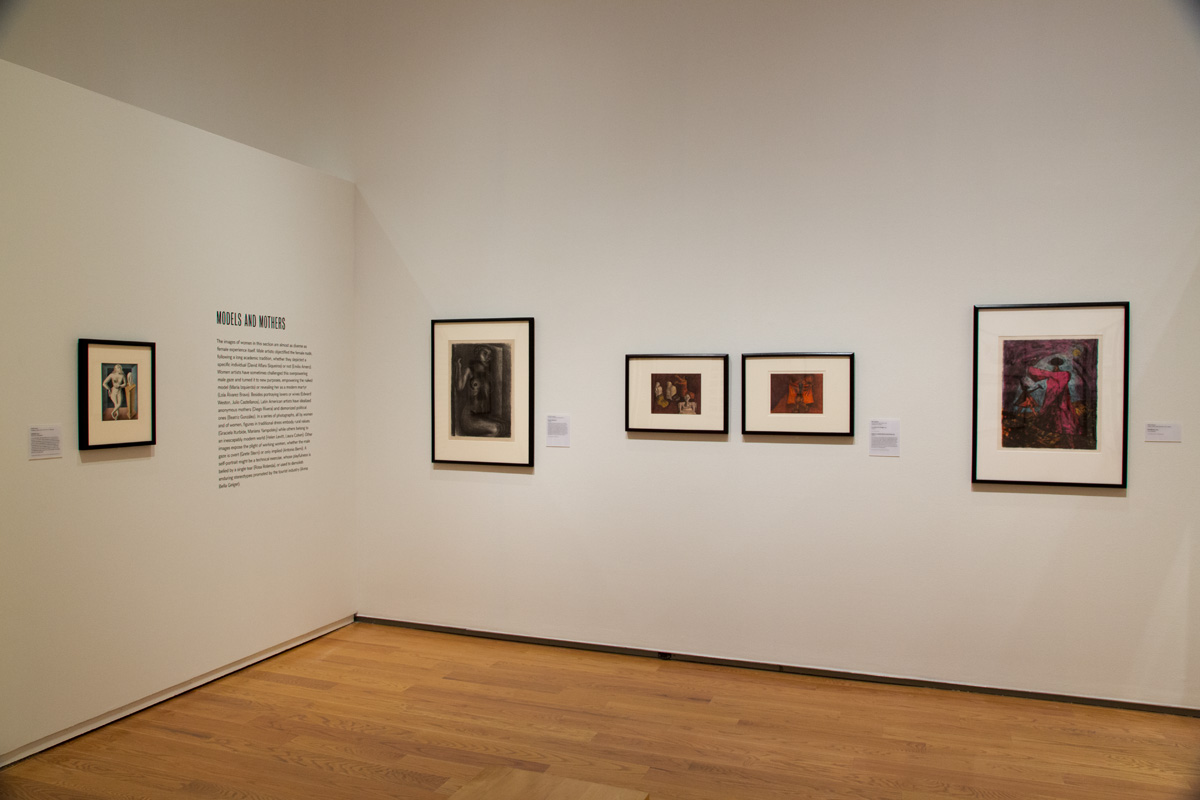The Davis Museum is closed for Wellesley College’s winter break. Please join us at our spring opening celebration on February 5, 2026, at 4 pm.
Models and Mothers

The images of women in this section are almost as diverse as female experience itself. Male artists objectified the female nude, following a long academic tradition, whether they depicted a specific individual or not. Women artists have sometimes challenged this overpowering male gaze and turned it to new purposes, empowering the naked model or revealing her as a modern martyr. Besides portraying lovers or wives, Latin American artists have idealized anonymous mothers and demonized political ones. In a series of photographs, all by women and of women, figures in traditional dress embody rural values while others belong to an inescapably modern world. Other images expose the plight of working women, whether the male gaze is overt or only implied. A self-portrait might be a technical exercise, whose playfulness is belied by a single tear, or used to demolish enduring stereotypes promoted by the tourist industry.

Emilio Amero (Ixtlahuaca, Mexico 1901 – 1976 Norman, Oklahoma), Untitled, 1933, Watercolor and graphite, Museum purchase, The Nancy Gray Sherrill, Class of 1954, Collection Acquisition Fund 2018.164
In the late 1920s, moving between New York and Havana, Mexican artist Emilio Amero worked as a caricaturist and commercial illustrator, while following some of the most avant-garde currents in photography and painting. This previously-unknown drawing confirms Amero’s interest in Surrealism, and especially in the work of Giorgio de Chirico.

Rosa Rolanda de Covarrubias (Azusa, California 1895 – 1970 Mexico City, Mexico), Self-Portrait, c. 1930, Gelatin silver print (photogram), Museum purchase, Ina Brown Ramer (Class of 1956) Endowed Fund for Acquisitions and Educational Program Support 2018.179. Courtesy of the artist's estate.
Mexican-American artist Rosa Rolanda (a stage name for Rosamonde Cowan Ruelas) gave up her dance career to marry the Mexican artist Miguel Covarrubias in 1930. Around that time she created a series of photograms, an avant-garde technique in which objects are placed on photosensitive paper and then exposed to light. Rolanda’s photograms include self-portraits, probably drawn on acetate, and personal objects like shells, a silver butterfly pin from Taxco, and a brown jade deer she acquired on a trip to Shanghai (the deer is now in the Davis Museum collection). This particular photogram, with a prominent tear, may refer to Edward Weston’s 1924 portrait of Tina Modotti.

Grete Stern (Elberfeld, Germany 1904 – 1999 Buenos Aires, Argentina), Sueño 26, Llamada (Dream 26, Telephone Call), 1949, Gelatin silver print (photomontage), Museum purchase with funds provided by Wellesley College Friends of Art 2012.9. The Estate of Grete Stern, Courtesy Galería Jorge Mara – La Ruche.
German-Jewish photographer Grete Stern moved to Buenos Aires in 1935. Once in Argentina, her work took on a more explicitly feminist tone, particularly in a series of photomontages created for Idilio, a weekly women’s magazine. Stern illustrated a column called “Psychoanalysis Will Help You,” in which two male intellectuals interpreted letters sent in by women readers, describing their anxieties, fears, and dreams. Her photomontages often contradicted the men’s theories: in Telephone Call the woman’s difficulty in communicating (the phone is too large) may be due to the sinister and controlling gaze of a shop owner, who menacingly holds a butcher’s knife just beside her.

Beatriz González (b. 1938 Bucaramanga, Colombia), Mi lucha (My Struggle), 1974, Screenprint, Museum purchase with funds provided by Wellesley College Friends of Art 2015.43. Courtesy of the artist and Casas Riegner, Bogotá.
Beatriz González’s silkscreen print My Struggle is based on a painting that she set into an actual serving tray. The image, derived from a newspaper clipping, shows María Eugenia Rojas, daughter of a former dictator, and the most prominent and powerful woman in Colombian politics, flanked by her two young sons. Her flat and brightly colored style was inspired by international Pop art, and she adopted the strategy of Andy Warhol. Her distorted image questions the power wielded by Rojas and the effects of her media presence.

Anna Bella Geiger (b. 1933 Rio de Janeiro, Brazil), Brasil nativo, Brasil alienígena (Native Brazil, Alien Brazil), 1976-77, Offset (18 postcards), Museum purchase with funds provided by Wellesley College Friends of Art 2016.110. Courtesy of the artist.
In Native Brazil, Alien Brazil, Anna Bella Geiger appropriated the postcard format to subvert stereotypes promoted by the tourist industry, and to undermine the artificial division between “native” and “alien” identity. She paired commercially-produced postcards that depict indigenous people from different communities in the Amazon Basin with others that show the artist and her friends in the patio of her Rio de Janeiro apartment, reenacting the original scenarios. The newly created postcards undermine the false theatricality of the commercial ones: for Geiger, Brazilian identity is defined less by place or ethnicity than by who claims the right to represent it.